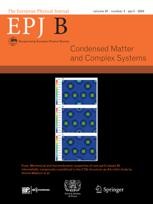What protects minority languages from extinction?
Mathematical modelling of competing languages in a geographical area suggests two scenarios in which one or more minority languages will be more likely to survive.
New York | Heidelberg, 21 April 2020
 Over 6,000 languages are currently spoken worldwide, but a substantial minority - well over 5% - are in danger of dying out. It is perhaps surprising that this fraction is no higher, as most models have so far predicted that a minority language will be doomed to extinction once contacts with speakers of the majority language reach a certain level. Statistical physicists Jean-Marc Luck from Université Paris-Saclay, Paris, France and Anita Mehta from the University of Oxford, UK have described, using mathematical modelling, two mechanisms through which this doomsday scenario does not occur, i.e. several languages come to coexist in the same area. This work is now published in EPJ B.
Over 6,000 languages are currently spoken worldwide, but a substantial minority - well over 5% - are in danger of dying out. It is perhaps surprising that this fraction is no higher, as most models have so far predicted that a minority language will be doomed to extinction once contacts with speakers of the majority language reach a certain level. Statistical physicists Jean-Marc Luck from Université Paris-Saclay, Paris, France and Anita Mehta from the University of Oxford, UK have described, using mathematical modelling, two mechanisms through which this doomsday scenario does not occur, i.e. several languages come to coexist in the same area. This work is now published in EPJ B.
Clearly, some languages will be more popular than others, because, for example, of their universal utility: Luck and Mehta parametrised this by ‘attractiveness’, which was a key variable in the coupled differential equations they devised to model language competition. Their equations turned out to belong to the class of Lotka-Volterra equations describing the dynamic relationship between predators and their prey.
The authors outlined two possible scenarios leading to language coexistence. The first of these concerns linguistic diversity: in a nation such as India, a regional language can, in a given state, coexist with the national languages spoken by the majority of the country. The second scenario is more subtle, where the coexistence of two or more languages is determined by the internal dynamics of the population of speakers in a given region. The simplest way of explaining this is to say that the dynamics between two competing languages in a single geographical area depends on the degree to which their speakers are mixed.
Luck and Mehta now intend to extend this model to explore the synchronous competition between different forms of past participles and the eventual survival of one, which is an important open problem in linguistics. They continue also to work on other problems in linguistics using the methods of statistical physics, such as the perception of speech.
References: J-M Luck and A Mehta (2020), On the coexistence of competing languages, European Physical Journal B 93:73, DOI: 10.1140/epjb/e2020-10038-1
Further Information
For more information visit: www.epj.org
Services for Journalists
The full-text article is available here.
Contact
Sabine Lehr | Springer | Physics Editorial Department
tel +49-6221-487-8336 | sabine.lehr@springer.com
